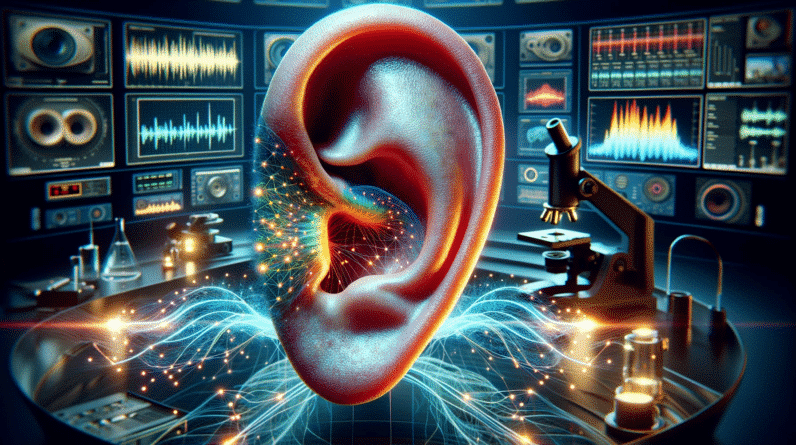
We may earn money or products from the companies mentioned in this post.
As an Amazon Associate I earn from qualifying purchases.
Tinnitus is quite the enigma – a hearing condition that is as fascinating as it is troubling. This buzzing or ringing that seems to emerge from nowhere has had scientists and sufferers in pursuit of truly understanding its nature. Out of the many forms that tinnitus takes, ‘Tonal Tinnitus’ is one subtype that stands out and will be the core focus of this discussion.
Tinnitus Explained
Tinnitus is an intriguing auditory disorder where a person hears noises like buzzing, hissing, or ringing even in the absence of an external sound source. Contrary to common misconceptions, it’s not really a disease but rather a symptom that could stem from a variety of causes such as exposure to loud noise, age-related hearing loss, or even specific medicines. For more insights into what causes this alarmingly common condition, head on over to this comprehensive guide on “what causes ear tinnitus“. You’ll certainly gain a more profound understanding of Tinnitus and its roots.
The Variety of Tinnitus
Tinnitus actually reveals itself in a variety of forms, each exhibiting characteristics as unique as the person suffering from it. It comes as no surprise then, that strategies for tinnitus management are specifically tailored around these different forms. One of these variants that’s been a topic of interest for both researchers and sufferers alike is ‘Tonal Tinnitus’. This subtype is notorious for its characteristic ‘musical’ quality, often described as an endless note playing in a sufferer’s ear. It might sound curious, but living with this continuous buzz is no easy feat. Get a clearer picture of how tonal tinnitus fits into the larger ‘tinnitus family’, along with other subtypes, in this comprehensive article on “kinds of tinnitus“.
While aiming to understand Tinnitus should always be encouraged, it’s also essential to remember that its complexity calls for patient navigation through various available resources. The American Tinnitus Association is an excellent source of rich, reliable information for those seeking to grasp the fine details of this condition. There’s always more to learn, after all!
The Tonal Subtype of Tinnitus
Now that we’re acquainted with the concept of Tinnitus, let’s delve into the mystery of its tonal variant. Tonal Tinnitus, as mentioned earlier, stands out with its harmonic quality – often like a persistent musical note that rings in one’s ears. Although ‘musical’ might initially sound soothing, sufferers attest to the continuous stimulation becoming a disruptive force in their daily lives.
Often, Tonal Tinnitus is associated with the perception of noise at a single or multiple frequencies. What’s more, the pitch of the perceived sound can often be correlated to the high-frequency hearing loss pattern seen in many sufferers. This makes it a unique experience for every individual dealing with it. To dig deeper into the fascinating world of Tonal Tinnitus, this concise but informative piece encapsulates beautifully the essence of this condition: “tonal subtype of tinnitus is best described as“.
Symptoms for Tinnitus
Diagnosing Tinnitus, let alone its tonal variant, isn’t as straightforward as one might think. This is mainly because it’s a symptom, not a disease – the manifestation of an underlying condition. For tonal tinnitus, typical symptoms include a perpetual ringing sound or a steady tone in the ear. This may be interspaced with periods of silence or softer noise.
Other symptoms could include minor discomfort in the ear, a sensation of pressure or fullness, or even temporary hearing loss. Remember, each person’s experience is unique, and the manifestation of symptoms can differ. For a deeper dive into Tinnitus signs, hop over here to symptoms for tinnitus.
Diagnosing Tonal Tinnitus
Diagnosing Tonal Tinnitus involves an elaborate process where audiologists undertake a series of tests to identify the precise characteristics of the condition. The evaluation usually begins with a medical history check and a physical examination of your ear. This is followed by a series of audiological exams to determine the pitch, loudness, and tone of the sound you’re experiencing.
Often methods, such as pitch masking, residual inhibition, and biofeedback, are employed in the diagnostic process. Tests for tinnitus gives a fantastic account of the step-by-step procedure involved in diagnosing Tinnitus.
It’s important to remember that Tinnitus and its subtypes like Tonal Tinnitus are not just about clinical definitions and symptoms. It’s about the lives of those that are affected by it- the trials, tribulations, and triumphs that they live every day. The [American Tinnitus Association] has some excellent resources for understanding the human side of this condition.
Treatment Options
Dealing with Tonal Tinnitus calls for a nuanced approach. Unlike specific injuries or illnesses, there isn’t a one-size-fits-all solution. It fundamentally depends on understanding the unique nature of your tinnitus, its causes, and how it impacts your daily life. That is why treatment options vary from patient to patient.
Some of these methods include sound therapies, cognitive-behavioral therapy, Tinnitus Retraining Therapy (TRT), and even certain medications. For an in-depth look into these options, feel free to visit does tinnitus go away. Remember, these don’t hold the promise of a complete cure but can significantly help manage symptoms and improve your quality of life. Consult with your healthcare provider to understand what might work best for you.
Case Study: Individuals with Tonal Tinnitus
The journey of individuals living with Tonal Tinnitus can be both enlightening and heartening. Real-life stories narrate countless instances of resilience and adaptability, offering a sense of camaraderie to those navigating similar paths. You can find some of these inspiring stories and more at tinnitus life expectancy.
Conclusion
In our quest to unravel the enigma of Tonal Tinnitus, we’ve journeyed through its definition, symptoms, diagnostic procedures, treatment options, and have even shared in the experiences of those living with this condition. The understanding of Tonal Tinnitus, like the condition itself, is continually evolving. It serves as a reminder that unceasing inquiry and empathy are central to addressing Tinnitus and similar complex phenomena effectively. As the famous physicist and philosopher Sir Arthur Eddington once said, “Not only is the universe stranger than we imagine, but it is stranger than we can imagine.” Tinnitus is no different. As we continue to explore its strange universe, each insight brings us one step closer to better managing this condition. It might be a tough journey, but remember, you are not alone. Let’s navigate this together!
Tonal Subtype Of Tinnitus Is Best Described As - Frequently Asked Questions (FAQ)
Tonal tinnitus is a form of tinnitus where the person hears a continuous sound at a single or multiple frequencies. This sound often has a ‘musical’ attribute, explained as a constant note playing in their ear.
For more information, visit our detailed guide on Tonal Tinnitus.
Like all forms of tinnitus, the precise cause of tonal tinnitus isn’t entirely understood. However, it’s often associated with the perception of noise at a single or multiple frequencies. Causes can vary from exposure to loud noise, age-related hearing loss, or certain medications.
Find more about it on our page detailing what causes tinnitus.
Tonal Tinnitus is diagnosed through a series of audiological exams where the pitch, loudness, and tone of the sound are identified. This is often done using methods like pitch masking, residual inhibition, and biofeedback. Find detailed insights about it here.
There are several treatment options available for tonal tinnitus, though it varies from patient to patient. These include sound therapies, cognitive-behavioral therapy, Tinnitus Retraining Therapy (TRT), and even certain medications. Refer to our page on does tinnitus go away for more information.
Yes, many people live full, healthy lives despite having Tonal Tinnitus. It’s all about finding ways to manage the condition effectively. Through a combination of lifestyle changes, therapies, and possibly medication, symptoms can be controlled to lessen their impact on your daily life. Read some inspiring stories at tinnitus life expectancy .
Amazon and the Amazon logo are trademarks of Amazon.com, Inc, or its affiliates.
No related posts.





